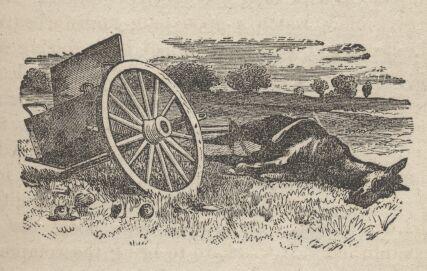This being the last of the original Pony Express stations on Bolivar Roberts division, was most likely built by his crew in the spring of 1860. The Transcontinental Telegraph was rapidly being constructed in 1861. As fast as outer stations were established, the important news of the day was sent to them by wire and transferred to the Pony Express. This meant that, so far as telegraphic communications were concerned, the Pony Express was playing a constantly lessening role. The newspapers, in introductory lines which were significantly descriptive, told of the progress of the telegraph across the country. Thus the San Francisco Bulletin of August 13, 1861 said the Pony Express rider was leaving his dispatches for the Bulletin and other Pacific Coast newspapers at Dry Creek station.
Dry Creek was used by the Overland Stage & Mail Company as a way stop from 1861 to 1869. It was from Dry Creek west that the stage route and Pony Express route differed slightly. The Pony traveled almost directly westward from here to the north of Eagle butte and on to Simpson Park. The stage went south around Cape Horn and then west. An additional station on the Overland, Cape Horn Station, was built on this longer route, that was not needed by the Pony.
(Expedition Utah)
Sources generally agree on the identity and use of this station by the Pony Express during its entire existence. Men under Bolivar Roberts probably established Dry Creek in the spring of 1860, which possibly served as a home station as well. Dry Creek, like several other stations, experienced Indian troubles in May 1860. Indians killed Ralph Rosier, the stationkeeper, and badly wounded his partner, John Applegate, who soon thereafter committed suicide. Two other men escaped to the next station. On October 11, 1860, when Richard Burton visited Dry Creek, he noted the grave of Rosier (a.k.a. Loscier) and Applegate and identified the stationkeeper as Col. Totten. Hubert Howe Bancroft indicated that because of Indian troubles, every station as far east as Dry Creek and Simpson Park, were broken up during the Pyramid Lake War.
The Overland Mail Company stage line also stopped at Dry Creek from 1861-1869 but reportedly used a separate structure from the Pony Express station.
Twenty miles farther led to the west end of the Sheawit Valley, where we found the station on a grassy bench at the foot of low rolling hills. It was a mere shell, with a substantial stone corral behind, and the inmates were speculating upon the possibility of roofing themselves in before the winter. Water is found in tolerable quantities below the station, but the place deserved its name, Dry Creek.
A fraternal recognition took place between Long Jim and his brother, who discovered each other by the merest accident. Gilston, the employe, was an intelligent man: at San Francisco he had learned a little Chinese, and at Deep Creek he was studying the Indian dialects. He had missed making a fortune at Carson Valley, where in June or July 1859 the rich and now celebrated silver mines were discovered; and he warned us against the danger of tarrying in Carson City, where revolvers are fired even into houses known to contain ladies. Colonel Totten, the station master, explained the formation of the gold diggings as beds of gravel, from one to 120 feet, overlying slate rock.
Dry Creek Station is on the eastern frontier of the western agency; as at Roberts' Creek, supplies and literature from Great Salt City east and Carson City west are usually exhausted before they reach these final points. After a frugal feed, we inspected a grave for two, which bore the names of Loscier and Applegate, and the date 21st of May. These men, employes of the station, were attacked by Indians - Panaks or Shoshonees, or possibly both: the former was killed by the first fire; the latter, when shot in the groin, and unable to proceed, borrowed under pretext of defense, a revolver bade good by to his companions, and put a bullet through his own head: the remainder then escaped. Both these poor fellows remain unavenged. The Anglo-American, who is admirably protected by the officials of his government in Europe, Asia, and Africa, is systematically neglected - teste Mexico - in America. The double grave, piled up with stones, showed gaps where the wolves had attempted to tunnel, and blue bottle flies were buzzing over it in expectation. Colonel Totten, at our instance promised that it should be looked to.
The night was comfortably passed at Dry Creek, under the leeward side of a large haystack. The weather was cold, but clear and bright. We slept the sleep of the just.
To Simpson's Park, 12th October.
At the time of the cold clear dawn, whose gray contrasted strongly with the blush of the most lovely evening that preceded it, the mercury stood at 45 F. Shortly after 8 AM we were afield, hastening to finish the long divide that separates Roberts Creek Valley from its western neighbor, which, as yet unchristened, is known to the b hoys as Smoky Valley.
(The City of the Saints, p 483-4)
